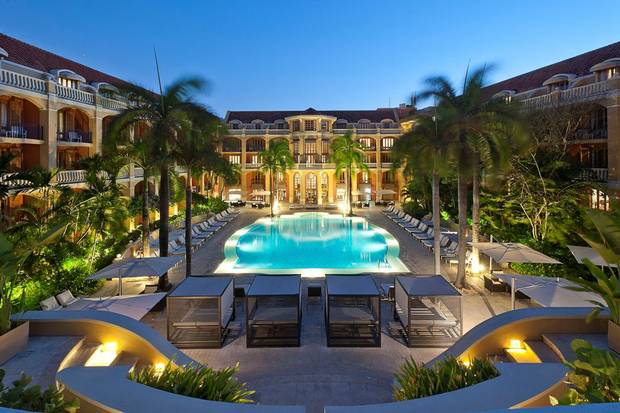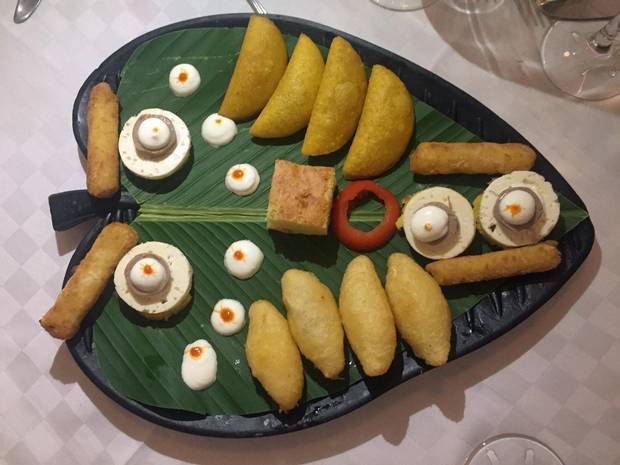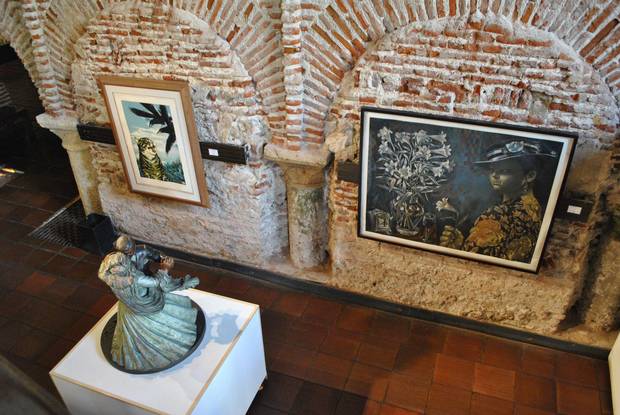There's a distinct rhythm to the walk along the jagged, thronging streets of Cartagena's Centro neighbourhood. Maybe it's the Afro-Colombian drum beats that spill nightly out of Plaza de Bolivar, the jaunty clip of horse carriages on the cobblestone or the salsa music that emanates from row-upon-row of stylish new hotels, shops and restaurants. When established by the Spanish 500 years ago, this fortified New World outpost would have been a tad less exuberant, what with its excess of churches, convents and the pious households of high-born colonials. Even a Cartagenian time traveller from 10 years ago would be astonished to find her drab, neglected barrio restored to its original opulence and repainted a Technicolor dream. To outsiders, a decade would seem a quick transformation, but it's been a long one for Colombia's tourism industry, still shaking off the country's FARC and narco legacies. It took not only time, but also the emergence of a new style of Caribbean traveller, one keener on culinary discovery and urban experiences than all-inclusives and idling on the beach. Now, with Cartagena's recent history blurry in the jetset's rearview, this cool and cultivated city has become one of the trendiest places to be.
Stay
Sofitel Legend Santa Clara

This luxury hotel celebrates Colombia’s modern artists.
Chris Kewish/handout
Its location in a 400-year-old former convent only adds to the allure of Centro's original luxury hotel. Wander in any direction and you'll run into a relic from the Clarissine order of nuns, once cloistered for life within the convent's walls. The cocktail bar was the choir pit; the breakout room, the bell tower and the wine cellar was Mother Superior's office. Meanwhile, four suites celebrate Colombia's modern artists, including Fernando Botero, whose original paintings of exaggeratedly full-figured women adorn the walls of his namesake suite. The newest pays tribute to the late Enrique Grau. His maria-mulata bird sculptures are a much-replicated symbol of Cartagena. One section of the hotel is devoted to Gabriel Garcia Marquez, the late writer whose family home is just next door. In 1949, while working as a reporter, Marquez attended an excavation of the convent's crypt and, inside a centuries-old casket, he saw a 20-metre cascade of still-radiant copper hair. Nearly 50 years later, he wrote Of Love and Other Demons, the fictional backstory of that ethereal muse. Not surprisingly, guests and locals alike come to take in the hotel's lore – along with lunch in the lush courtyard, the legendary mojitos at El Coro and the tartars prepared tableside at 1621, one of the city's top fine-dining restaurants. Rooms starting at US$600 a night. Carrera 8 No. 39-29; sofitel.com.
Eat and drink
La Vitrola
The original owner, Maria Josefina Yances, turned her one-time taberna into a haven for Cartagena's culturati back in 1983. Artists, writers, politicians and beauty queens dined, danced and drank the night away within its hallowed walls. Even now, made over as an elegant French bistro, it retains its festive ambience through a combination of vintage tropical furnishings, live Latin music and bustling white-glove table service, while still catering to a who's who of Colombian society. As a side note, Yances's nephews opened a tribute to their late aunt. La Cocina de Pepina, in the neighbouring hipster district of Getsemani, serves up coastal comfort food. Despite the low-key locale, Pepina's six tables are some of the hottest in town. La Vitrola: Carrera 2 No. 33-66 / La Cocina de Pepina: Calle 25 No. 10B-6.
Carmen
This restaurant ticks all the style boxes, from its low-lit palm-strewn patio to its seventies revivalist decor. But that's where the brush with familiarity ends. On the menu, chef Carmen Angel soups up ingredients with exotic flavours, such as the ceviche laminado, cut with coconut smoke, sweet kelp and copoazu (an Amazonian fruit related to cacao). Her croquettes, made with cassava and the saffronesque achiote, have a liquid centre of foie gras and black truffle. Calle 38 No. 8-19; carmencartagena.com/en.
Candé

At Candé in Cartagena, small bites are charmingly arranged as patterns on palm fronds.
NATASHA MEKHAIL/globe and mail
Candé is a living tableau. Its female servers wear a modern take on the peasant blouses and head wraps of the iconic Palenquera women who sell fruit in the city; the vine-riddled stone walls suggest the villa of an eccentric Colombian aristocrat; small bites are charmingly arranged as patterns on palm fronds; and, astonishingly, the regular appearance of two costumed folk dancers neither annoys (in that touristy way) nor interferes with the service – it's just part of the overall artistry. Candé also serves two Cartagenian guilty pleasures, both prepared with soft drinks as the chief ingredient. Posta Negra is beef round roast braised in Coca-Cola, while the plantains "en tentacion" get their flavour (and hot-pink hue) from cherry soda. Carrera 5 No. 35-30; restaurantecande.com.
Shop
Calle 35
Clustered around the main shopping drag, the concept-store movement has taken off and these multilabel shops provide the best venues for picking up a showpiece souvenir. Visit St. Dom for playful patterned clutches and oversized accessories – the shop stocks Colombian designers exclusively. Agua de Leon sells sculptural swimwear and headpieces that Frida Kahlo would covet. And El Centro Artesano works directly with indigenous craftspeople to produce on-trend clothing and home decor (rattan lampshades, vueltiao sunhats and boho-chic caftans), while providing its artisans with business education and microfinancing. St. Dom: Carrera 3 No. 33-70; stdom.co; Agua de Leon: Calle 35, Plaza Santo Domingo; El Centro Artesano: Carrera 6 No. 36-121; elcentroartesano.com.
Loto del Sur
This beauty brand crafts exquisite all-natural products using native Colombian ingredients. Its cult items include delectable body scrubs using cocoa, sugar cane and mine salt, as well as linen sprays in fragrances such as orange water and verbena. For an apropos gift, pick up a bar of Cafe Arabico soap, made with the beans the country is famous for and packaged in its own mini burlap sack. Carrera 5 No. 34-37; lotodelsur.com.
Ketty Tinoco: Ketty Tinoco has been making her distinctive brand of linen wear since 1983. But while her designs began as a practical response to the equatorial heat, they've since evolved into a much larger statement. Her guayaberas, the standard men's white work shirt, has been reimagined in a spectrum of colours (pair it with a sharp white Panama-style toquilla hat for full effect). Tinoco's white-on-white women's co-ordinates have evolved, too, with ornate textural appliqués worthy of formal occasions. Plus, many of the adult staples are available in adorable minis for kids. Carrera 3 No. 33-01; kettytinoco.com.
Local secrets
Enrique Grau

Cartagena’s Museum of Modern Art.
NATASHA MEKHAIL/the globe and mail
Although Enrique Grau (1920-2004) is arguably the country's most important artist, he's little known outside Latin America (think of him as Colombia's Diego Rivera – minus the Marxism). Born into a well-to-do family, he used his talent and position to underscore injustices committed against Indigenous and Afro-Colombian people during the colonial era. But his work – steeped in the magical realism and vivid colour so characteristic of Latin America – also captures the beautiful simplicity of everyday life. Grau co-founded Cartagena's Museum of Modern Art in a former colonial weapons storehouse, donating much of his personal art collection. Museum of Modern Art: Calle 31 No. 69b69; mamcartagena.org.
Singular Luxury Travel
Whatever your sightseeing interest, this custom tour operator will pair you with a specialist guide: a working artist for gallery tours, a local stylist for shopping. But the real privilege is getting an invitation back to Casa Singular. While tourists rarely get a glimpse inside the homes of the Cartagenian elite who've restored the historic quarter, Singular's co-director, Ricardo Hernandez, has maintained this property as it would have appeared in the 1950s, with original furniture and artwork. Contact: +57-5-664-0736; singularltd.com.
Rosario Islands: Cartagena is not a beach destination, per se, but locals and tourists wanting the full Caribbean experience can book a day trip to one of the nearby Rosario Islands. The string of 30 islets is said to resemble the rosary and is named accordingly. Head to one of the larger cays, such as Isla Grande, offering day facilities, food and libations. On the speedboat ride out, you may pass the private island of the President or the micro-islet where Botero has a home; rosarioislands.com.
The writer was a guest of Sofitel Legend Santa Clara. It did not review or approve this article.

